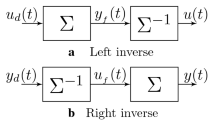Abstract
The residual vibration caused by joint flexibility tends to be nonlinear and time-varying due to the complicated dynamics characteristics of 6-DOF industrial robot. To address the time-varying residual vibration problem, this paper proposes a pre-adaptive input shaping method. By simplifying the 6-DOF industrial robot standard flexible dynamics equation, the flexible dynamical parameters can be identified without additional joint encoders or other measuring instrument, while the natural frequency of each joint can also be calculated from the identified dynamical parameters. Then by setting the calculated natural frequency as the initial condition, an iterative learning scheme based on the secant method can be applied to obtain a better natural frequency estimate. Finally, using the iteration results, the input shaper’s parameters can be updated, which makes the shaper adapt to the variation of system parameters. The results of model validation show that the simplified dynamic model can reflect the robot dynamic characteristics accurately. The vibration experimental results demonstrate the effectiveness of the proposed pre-adaptive input shaper in suppressing the residual vibration.
Similar content being viewed by others
References
J.-H. Park and S. Rhim, Experiments of optimal delay extraction algorithm using adaptive time-delay filter for improved vibration suppression, J. of Mechanical Science and Technology, 23 (4) (2009) 997–1000.
S.-W. Hwang, J.-H. Bak, J. Yoon, J.-H. Park and J.-O. Park, Trajectory generation to suppress oscillations in under-constrained cable-driven parallel robot, J. of Mechanical Science and Technology, 30 (12) (2016) 5689–5697.
W. Singhose, Command Generation for Flexible Systems, Massachusetts, MA, USA: MIT (1997) 61–112.
J. Vaughan, A. Yano and W. Singhose, Comparison of robust input shapers, J. of Sound and Vibration, 315 (2008) 797–815.
W. Singhose, L. Porter and N. Singer, Vibration reduction using multi-hump extra-insensitive input shapers, Proceedings of American Control Conference (Seattle, WA), Pis-cataway, NJ, USA (1995) 3830–3834.
W. Singhose, E. Biediger, Y.-H. Chen and B. Mills, Reference command shaping using specified-negative-amplitude input shapers for vibration reduction, J. of the Dynamic Systems, Measurement and Control, 126 (2004) 210–214.
W. Singhose, W. Seering and N. Singer, Time-optimal negative input shapers, J. of the Dynamic Systems, Measurement and Control, 119 (1997) 198–205.
S. Rhim and W. Book, Noise effect on adaptive command shaping methods for flexible manipulator control, IEEE Transaction on Control Systems Technology, 9 (1) (2001) 84–92.
S. Rhim and W. Book, Adaptive time-delay command shaping filter for flexible manipulator control, IEEE/ASME Transaction on Mechatronics, 9 (4) (2004) 619–626.
A. Tzes and S. Yurkovich, An adaptive input shaping control scheme for vibration suppression in slewing flexible structures, IEEE Transactionon Control Systems Technology, 1 (2) (1993) 114–121.
F. Khorrami, S. Jain and A. Tzes, Experimental results on adaptive nonlinear control and input preshaping for multi-link flexible manipulators, Automatica, 31 (1) (1995) 83–97.
E. Pereira, J. Trapero, I. Diaz and V. Feliu, Adaptive input shaping for manoeuvring flexible structures using algebraic identification technique, Automatica, 45 (2009) 1046–1051.
E. Pereira, J. Trapero, I. Diaz and V. Feliu, Adaptive input shaping for single-link flexible manipulators using an algebraic identification, Control Engineering Practice, 20 (2012) 138–147.
J. Park and P.-H. Chang, Learning input shaping technique for non-LTI systems, J. of Dynamic Systems, Measurement, and Control, 123 (2) (2001) 288–293.
J. Park, P.-H. Chang, H.-S. Park and E. Lee, Design of learning input shaping technique for residual vibration suppression in an industrial robot, IEEE/ASME Transaction on Mechatronics, 11 (1) (2006) 55–65.
H.-S. Park, H. Chang and J.-S. Hur, Time-varying input shaping technique applied to vibration reduction of an industrial robot, Control Engineering Practice, 13 (2005) 121–130.
H. Kojima, S. Ieda and S. Kasai, Frequency-tuning input-shaped manifold-based switching control for underactuated space robot equipped with flexible appendages, Acta As-tronautica, 101 (2014) 42–54.
M. Spong, Modeling and control of elastic joint robots, J. of Dynamic Systems, Measurement, and Control, 109 (1) (1987) 310–319.
M. Pham, M. Gautier and P. Poignet, Identification of joint stiffness with bandpass filtering, Proceedings of the 2001 IEEE International Conference on Robotics and Automation, Piscataway, NJ, USA (2001) 2867–2872.
J. Swevers et al., Optimal robot excitation and identification, IEEE Transactions on Robotics and Automation, 13 (5) (1997) 730–740.
L. Y. Pao, Analysis of the frequency, damping, and total insensitivities of input shaping designs, J. of Guidance, Control and Dynamics, 20 (5) (1997) 909–915.
M. O. T. Cole and W. Theeraphong, A direct method of adaptive FIR input shaping for motion control with zero residual vibration, IEEE Transaction on Mechatronics, 18 (1) (2013) 316–327.
Author information
Authors and Affiliations
Corresponding author
Additional information
Recommended by Associate Editor Baek-Kyu Cho
Tie Zhang received his Ph.D. from South China University of Technology in 2001. He is currently a Professor and a Ph.D. candidate supervisor of the School of Mechanical & Automotive Engineering, South China University of Technology. His main research interests include design and control of robots, automation and intelligent systems.
Rights and permissions
About this article
Cite this article
Zhang, T., Lin, K. & Zhang, A. Research on flexible dynamics of a 6-DOF industrial robot and residual vibration control with a pre-adaptive input shaper. J Mech Sci Technol 33, 1875–1889 (2019). https://doi.org/10.1007/s12206-019-0340-z
Received:
Revised:
Accepted:
Published:
Issue Date:
DOI: https://doi.org/10.1007/s12206-019-0340-z




